by India Knight from The Sunday Times
I spent quite a lot of time on holiday cajoling my eldest son (he’s 13) to at least attempt to make inroads into his reading list for next year. He sat on the beach reading Dr. Jekyll and Mr. Hyde, which was encouraging, and then decided he’d done plenty and needed to devote much more of his time to surfing and hanging out.
What about Waugh, I cried. Greene? Siegfried Sassoon? Oh look, Selections from the Aeneid — I’ll pay you to read it. But he was gone.
When I dropped this same son off to go on a school trip to France last year, I was amazed to see one of his friends, who’d got there early, sitting on a wall doing the Telegraph’s cryptic crossword, if you please. I felt a stab of purest envy.
This paragon is no doubt spending his summer holiday reading Riddles in Mathematics by Eugene P. Northrop, also on our reading list and doomed, I fear, forever to gather dust in our innumerate house. I bet this child devours Virgil and can quote from Decline and Fall.
Whenever I order my son to be more like him, which I do at least twice a week, he smiles beadily and says: “But he’s a boffin.” So? So, being a boffin is a fate worse than death, apparently. The only thing that saves this child from gross unpopularity and ostracism is that he is also a) funny b) nice-looking and c) crucially, good at games.
I have explained patiently to my son that if he were to make a small effort academically, Stephen Hawking would probably still manage to sleep at night, but to no avail. Being seen as actively clever is now apparently socially unacceptable, and his friend is the lone and freakish exception to the overwhelming rule.
Last week, delegates at the 35,000-strong Professional Association of Teachers’ annual conference were told they should stop telling their pupils they are “clever” because it is “uncool”. They should instead use the more thrusting, businessy term “successful”.
Simon Smith, a teacher from Essex, told the conference: “A culture has developed that mocks being clever... I have talked to various pupils. They said being clever meant you were boring, lacked personality, were a teacher’s pet and other things not polite to mention in company such as this. With a few exceptions, including sport, academic prowess is in many eyes not ‘cool’. We need to change this, perhaps by changing the language we use.”
Another teacher said pupils often failed to turn up to collect their awards at prize-giving “because it is not cool”, and a third pointed out that achievers and Nobel prize winners were not considered celebrities, unlike people who’d made a virtue out of undistinguished academic careers, such as Alan Sugar or David Beckham.
Other teachers spoke of clever pupils deliberately making their work second-rate “because of peer pressure not to appear bright, clever or hardworking”.
Now, we all had a class swot, hand permanently up, panting with their love of knowledge, keen on double maths and given to a little light dissection of mammals in their spare time.
Nobody’s suggesting we need more of those: being the class geek, or nerd, or boffin, is not necessarily a number one priority when you’re 13, and a trip to the cinema is always going to be more fun than impromptu revision. However, there used to be kudos attached to cleverness, especially for those who developed the trick of making it seem effortless.
That seems to be a thing of the past: at school, as increasingly throughout society, thickness, or the appearance of thickness, is where it’s at.
It doesn’t seem to occur to David Beckham’s admirers — or Alan Sugar’s, for that matter — that working hard at school might have meant their hero was a clever football player, as opposed to a notoriously dim one, or that Alan Sugar might have made even more money than he has already if he had got a few qualifications.
Nor does it occur to them that for every Richard Branson there are a thousand undereducated miserable people, massively chippy more often than not (and with good reason), who wish they’d stayed on at school. Maybe they should take to heart the sobering statistic that 40% of criminals in our jails are illiterate.
We also heard last week that schools may soon no longer be required to teach children the difference between right and wrong, if plans to revise the core aims of the national curriculum are to go ahead. Teachers would instead be asked to encourage pupils to develop “secure values and beliefs”, though what those values might be is anyone’s guess. The draft proposals also delete any reference to promoting leadership skills, and remove the requirement to teach children about Britain’s cultural heritage.
Barmy, isn’t it. It’s bad — and loony — enough that we exist in a culture that encourages all school children to feel “special” and “equal” in terms of talent and opportunities: a really stupid lesson to teach them, given that it is a fact of life that some people are demonstrably cleverer than others, and demonstrably more likely to succeed, and some people, despite their best efforts, are just thick.
But no: all must have prizes and pats on the head, and the demoralised stupid children must be made to struggle terribly in mixed-ability classes while the understimulated clever ones yawn and look out of the window.
Never mind: in the instant gratification society we live in, every one of those children genuinely believes that success and riches are their due and will land on their lap by magic, either through reality TV or, well, just like that. We are raising a generation that is going to be massively disappointed.
The world of school increasingly bears little or no resemblance to the real world: no streaming, no competitive games, and now nobody being encouraged to develop leadership skills, to want to be clever, or to familiarise themselves with ethics. Instead we get ignorance and moral relativism for school-age children, who are too badly educated to even make sense of the concept. No wonder we’re dumbed down.
Victoria Beckham, who’s made a career out of being skinnier and more ill-looking than a famine victim — nice — has had her hideous hair extensions chopped off and replaced with a strange, studenty bob. Hold the front page! Many tabloids did, last week, to heap praise upon this most unlikely of “style icons”. Meanwhile, poor old Zara Phillips went somewhere wearing a boob tube — a green cotton strapless top — and got bashed for it all over the Daily Mail. Phillips is a super-fit Olympic-quality horsewoman, who dresses like an ordinary girl and has an ordinary, athletic shape. Posh is a pin-up for pro-anorexia websites and, according to Grazia magazine, has the waist-size of a seven-year-old girl.
Why does anyone bother maintaining the crazy fiction that she is any kind of role model, or that her slightly simian, emaciated size 0 looks are aesthetically pleasing and somehow worthy of being aped, and that anyone who’s a size 12 or 14 is a gigantic heifer? Is everybody mad? I mean, who is abnormal here? It’s certainly not Zara. But all this is just unbelievably depressing.
Wednesday, October 25, 2006
Friday, October 06, 2006
Children's paintings
I've been wanting to post some paintings up for some time now. I think I should get down to actually doing it this time. Pet, hope this is what you will see on the walls of my mum's place.
Ladies and gentlemen, the paintings you will see below were painted by children from 5 to 8 years of age. 'Art classes', as they are fondly referred to in Malaysia, are held on Saturday mornings. Mum stopped hiring so-called art teachers from external sources as they were too rigid. They would draw something on the board and say, "Ok, you follow that and then you choose your colours to paint in la"...... where's the creativity in that? You would hear phrases like, "How can you use this colour?" or "No, you don't draw that here. You draw that on this side" or "No, rub this off". Ring any bells?
Dad's approach is slightly different. His children do not paint while sitting down at individual tables. Instead, they paint standing up at painting easles set up in a way that allows them to observe and interact with other children.He arrives early (or else Mum would tell him off), briefs the teachers on what he would like them to do, and explain it to the children. He has two groups of chidlren. The younger group is taught the basics of colours, i.e. one week would be warm colours and another week would be cold. Once they get a hang of the concept, they then work with 2 colours like red and yellow. Dad only provides them with the primary colours of red, yellow and blue. Once they 'accidentally' find out how they make other colours out of all of that, they move on to more complicated things like brush techniques. Then, white and black would be added to their palette.

Yuk Khey used to tease me a lot. And he did that in perfect English! He'd go, "Shi Jing Jie Jie, how come you don't like to wear pretty skirts?" And I'd be speechless. Yuk Khey was 6 when he painted this. Dad wanted them to learn not to 'mess up' their work. And this painting was also to allow them to practice their waving skills. And they just learnt how to mix green and brown.

Another technique lesson, this lesson focussed on only 2 colours. Dad wanted them to learn that the paint brush is a powerful tool for evoking different emotions when used properly with the right colour combinations. Ming Suet's simple painting here shows you that with the right amount of guidance, children are capable of producing real paintings, not just cartoon-looking drawings and bright colour-me-in run-offs. Ming Suet is one child I am very fond of because she's been with us since she was 3. She is still with us and now she's 9!

Marcus speaks fluent English and was the star of our 2004 concert as he was in the English drama as the lead character. He has a cheerful personality and loves to talk in his high-pitched voice. It does seem strange that the expressions on the faces he painted are more of the negatives than positives. Wonder if this shows anything about life at home or outside of the Centre?
Dad also used real-life objects. His favourite are fruits and vegetables because all he needed to do was either grab them from home and from the kitchen.

Kien Hing was 7 when he did this painting. Dad put up a banana on the easle for them to follow and it was up to them to paint it however they liked. He came to us when he was 3 and his best friend was Dana. His family runs a wantan mee stall in an old coffeeshop in the middle of the wet market in the heart of Seri Kembangan. The teachers don't particular enjoy his presence in the room because he won't sit still but I find that if you make yourself and your lessons interesting, he WILL sit and listen to you.
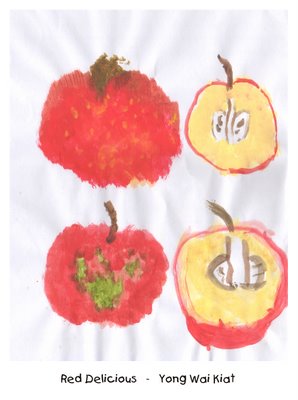
Another fruit lesson was the apple one. Pretty straightforward. Wai Keat was 7 and his dad placed him in the lessons because he didn't want him to be lazing around at home. Good idea.

One of my lecturers actually thought that was a painting of a bird. But anyways, I'm sure you are able to tell what it actually is. Dad didn't prepare for this lesson so he went into the kitchen and grabbed a few onions and presto! Don't you feel amazed at what Jia Ern, only 6 at the time she did this, could mix the colours and differetiate between the inside and outside of the onion? She is now 8 and the last I heard, she is top of her class and Model Student of the Year.
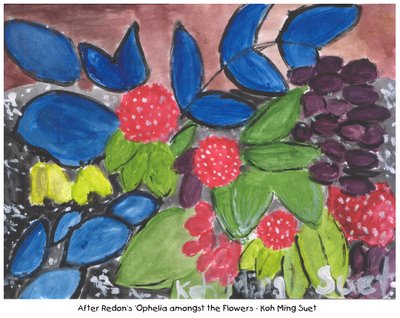
Dad introduced the masterpiece to the children in reaction to the children's thinking that 'flowers are all in pretty and bright colours'. They are conforming to what is considered normal and I don't blame them for that. No one has ever taught them to challenge what is considered normal and Dad wanted to show them that it is alright to paint flowers in black or leaves in blue. It's art so have some fun! And fun was what Ming Suet had! She thought of the background on her own and the white and black dots, just unexpected!

Until today, this is still my favourite painting. When Hao Yan first came to us, she was rude and 'rough'. She was very stubborn and used to bite other children when she didn't get things to go her way. Her mother had just transferred her from a play-based childcare centre thinking that 'she's had enough of playing'. Parents sometimes do not realise that playing is actually learning. But yes, she transformed and just look at this sunflower! Look at the brush strokes, the interplay of colours, the balance. This was the lesson where Dad showed them the different sunflowers painted by Van Gogh and Klimt.
When you are confident and trust the children with your material, when the children enjoy your lessons and when you do not set boudaries for them, you will find that children have the most remarkable imaginations.
Ladies and gentlemen, the paintings you will see below were painted by children from 5 to 8 years of age. 'Art classes', as they are fondly referred to in Malaysia, are held on Saturday mornings. Mum stopped hiring so-called art teachers from external sources as they were too rigid. They would draw something on the board and say, "Ok, you follow that and then you choose your colours to paint in la"...... where's the creativity in that? You would hear phrases like, "How can you use this colour?" or "No, you don't draw that here. You draw that on this side" or "No, rub this off". Ring any bells?
Dad's approach is slightly different. His children do not paint while sitting down at individual tables. Instead, they paint standing up at painting easles set up in a way that allows them to observe and interact with other children.He arrives early (or else Mum would tell him off), briefs the teachers on what he would like them to do, and explain it to the children. He has two groups of chidlren. The younger group is taught the basics of colours, i.e. one week would be warm colours and another week would be cold. Once they get a hang of the concept, they then work with 2 colours like red and yellow. Dad only provides them with the primary colours of red, yellow and blue. Once they 'accidentally' find out how they make other colours out of all of that, they move on to more complicated things like brush techniques. Then, white and black would be added to their palette.

Yuk Khey used to tease me a lot. And he did that in perfect English! He'd go, "Shi Jing Jie Jie, how come you don't like to wear pretty skirts?" And I'd be speechless. Yuk Khey was 6 when he painted this. Dad wanted them to learn not to 'mess up' their work. And this painting was also to allow them to practice their waving skills. And they just learnt how to mix green and brown.

Another technique lesson, this lesson focussed on only 2 colours. Dad wanted them to learn that the paint brush is a powerful tool for evoking different emotions when used properly with the right colour combinations. Ming Suet's simple painting here shows you that with the right amount of guidance, children are capable of producing real paintings, not just cartoon-looking drawings and bright colour-me-in run-offs. Ming Suet is one child I am very fond of because she's been with us since she was 3. She is still with us and now she's 9!

Marcus speaks fluent English and was the star of our 2004 concert as he was in the English drama as the lead character. He has a cheerful personality and loves to talk in his high-pitched voice. It does seem strange that the expressions on the faces he painted are more of the negatives than positives. Wonder if this shows anything about life at home or outside of the Centre?
Dad also used real-life objects. His favourite are fruits and vegetables because all he needed to do was either grab them from home and from the kitchen.

Kien Hing was 7 when he did this painting. Dad put up a banana on the easle for them to follow and it was up to them to paint it however they liked. He came to us when he was 3 and his best friend was Dana. His family runs a wantan mee stall in an old coffeeshop in the middle of the wet market in the heart of Seri Kembangan. The teachers don't particular enjoy his presence in the room because he won't sit still but I find that if you make yourself and your lessons interesting, he WILL sit and listen to you.

Another fruit lesson was the apple one. Pretty straightforward. Wai Keat was 7 and his dad placed him in the lessons because he didn't want him to be lazing around at home. Good idea.

One of my lecturers actually thought that was a painting of a bird. But anyways, I'm sure you are able to tell what it actually is. Dad didn't prepare for this lesson so he went into the kitchen and grabbed a few onions and presto! Don't you feel amazed at what Jia Ern, only 6 at the time she did this, could mix the colours and differetiate between the inside and outside of the onion? She is now 8 and the last I heard, she is top of her class and Model Student of the Year.

Dad introduced the masterpiece to the children in reaction to the children's thinking that 'flowers are all in pretty and bright colours'. They are conforming to what is considered normal and I don't blame them for that. No one has ever taught them to challenge what is considered normal and Dad wanted to show them that it is alright to paint flowers in black or leaves in blue. It's art so have some fun! And fun was what Ming Suet had! She thought of the background on her own and the white and black dots, just unexpected!

Until today, this is still my favourite painting. When Hao Yan first came to us, she was rude and 'rough'. She was very stubborn and used to bite other children when she didn't get things to go her way. Her mother had just transferred her from a play-based childcare centre thinking that 'she's had enough of playing'. Parents sometimes do not realise that playing is actually learning. But yes, she transformed and just look at this sunflower! Look at the brush strokes, the interplay of colours, the balance. This was the lesson where Dad showed them the different sunflowers painted by Van Gogh and Klimt.
When you are confident and trust the children with your material, when the children enjoy your lessons and when you do not set boudaries for them, you will find that children have the most remarkable imaginations.
Thursday, October 05, 2006
My prac
For those of you who didn't know, I was on prac for 3 weeks at a local primary school teaching Year One children. There were 19 of them in my class and they were comparably an easy class. My co-operating teacher was Nadia. Only 28 and she's been teaching for 7 years. Let me show you some of the things I did with the kids while I was there.
Oh, before that, I have to show you this:
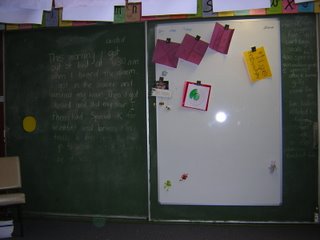
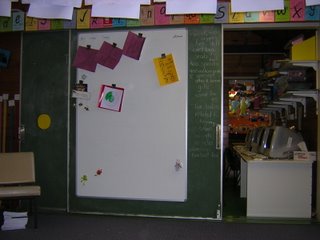
Smart, don't you think? The blackboard/whiteboard functions as a sliding door as well! It goes through into the computer lab cum store room and then connects to the next Year One class.
Okay, now, the stuff I've been doing with the kids. As they were starting to learn about wetlands, most of my lessons were planned based on wetlands. One of my targets was to make sure that the children were able to differentiate between the different types of roots mangroves have. This way, they'd have something to look out for when they go to Bicentennial Park for the excursion. One of my lessons involved a game. The children were split into groups and they had to choose a few person to match the pictures to the labels. Of course, they had to decide as a team which labels are to which pictures before I said start.
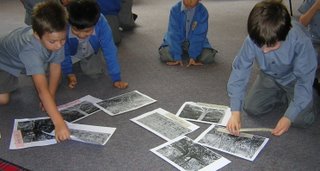
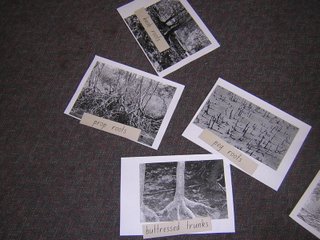
Of course, after having gone on an excursion, I had to ask them to draw what they saw or remembered.
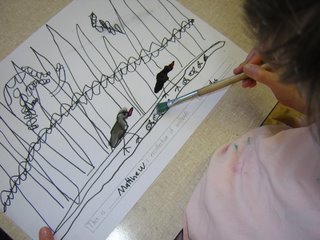
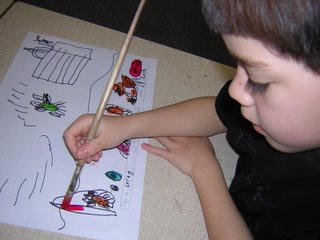
Okay, so we covered the plants of wetlands. We also had to learn about who lives in there. And of course, a familiar animal they could think of was the frog. And so we learnt about frogs for the next week or so. One of the things we did was to learn about the frog's life cycle. I used art to teach them about this. I used an idea dad told me a few years ago but instead of using only paint, I also used wobbly eyes. Look at the effect!
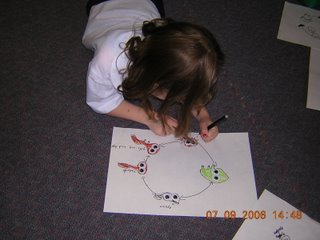

Notice how Max has drawn his frog and where he has placed the eyes! Haha!! Doesn't it look like that Japanese cartoon? Er, what's the name? Kero Kero Keropi or something like that...
We also made an origami frog. It was not easy for the kids, I tell you so it was great to see the frogs actually jump! Nicholas was so into folding the frogs, he could remember the steps and offered to fold more frogs for Friday Fun! We built a pond for the frogs to live in and the boys had frog races, too!
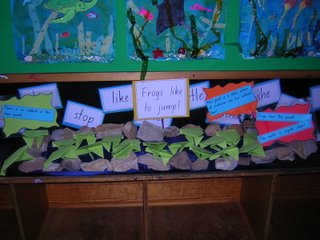
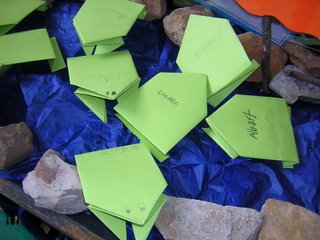
And when you have enough (or more than enough would be ideal) resources provided for the children, you will see that their investigating, curious, hypothetical selves will show. Just look at how Harrison and Calvin are enjoying themselves! Yes, they may not know how to read the entire book as it is way above their level, but the pictures will spur them to find out more.


We even learnt to draw and label the different body parts of a tadpole and a frog!

Not everything was about frogs and mangroves and wetlands. Nadia wanted to reintroduce patterns to the children. We used colour counters and asked the children to come up with a pattern of their own. Any pattern. Most of them came up with colours depicting their favourite football teams. Here is Calvin and the colours of the West Tigers:

Lachlan with the colours of the Parramatta Eels:
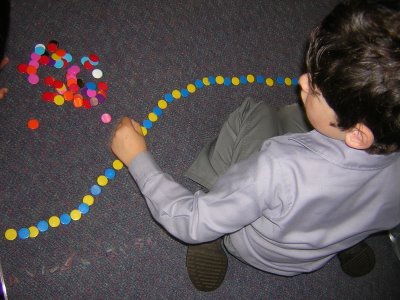
Martin and Harrison working collaboratively to get a long line of Sydney Swan colours:
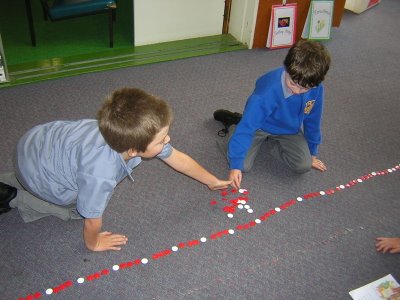
We did lots and lots of other things as well. I spent a lot of my lunchtimes with the kids playing catch and just simply holding hands walking round the oval. I taught them a percussion item to perform for assembly and we became friends. At the end of prac, there were surprises. Maddy gave me a card and a bracelet:

Corey found a pinecone and said, "Here, Miss Voon. Everytime you miss me, just look at this pinecone and it will remind you of me.". Aw......
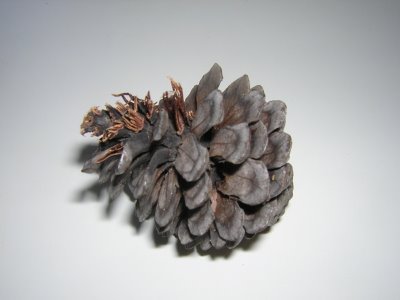
Rachel passed me a scruffy looking piece of paper which contained this:
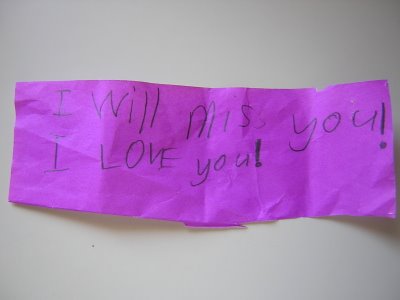
On the day I returned to school to collect a book I forgot and to watch the assembly item, the class presented me with a special card they made:


I would like to thank the kids, Nadia and my advisor, Robyn for having provided me with so much fun. I have learnt a lot from the prac and I will work hard to ensure my next prac will be even better.
Oh, before that, I have to show you this:


Smart, don't you think? The blackboard/whiteboard functions as a sliding door as well! It goes through into the computer lab cum store room and then connects to the next Year One class.
Okay, now, the stuff I've been doing with the kids. As they were starting to learn about wetlands, most of my lessons were planned based on wetlands. One of my targets was to make sure that the children were able to differentiate between the different types of roots mangroves have. This way, they'd have something to look out for when they go to Bicentennial Park for the excursion. One of my lessons involved a game. The children were split into groups and they had to choose a few person to match the pictures to the labels. Of course, they had to decide as a team which labels are to which pictures before I said start.


Of course, after having gone on an excursion, I had to ask them to draw what they saw or remembered.


Okay, so we covered the plants of wetlands. We also had to learn about who lives in there. And of course, a familiar animal they could think of was the frog. And so we learnt about frogs for the next week or so. One of the things we did was to learn about the frog's life cycle. I used art to teach them about this. I used an idea dad told me a few years ago but instead of using only paint, I also used wobbly eyes. Look at the effect!


Notice how Max has drawn his frog and where he has placed the eyes! Haha!! Doesn't it look like that Japanese cartoon? Er, what's the name? Kero Kero Keropi or something like that...
We also made an origami frog. It was not easy for the kids, I tell you so it was great to see the frogs actually jump! Nicholas was so into folding the frogs, he could remember the steps and offered to fold more frogs for Friday Fun! We built a pond for the frogs to live in and the boys had frog races, too!


And when you have enough (or more than enough would be ideal) resources provided for the children, you will see that their investigating, curious, hypothetical selves will show. Just look at how Harrison and Calvin are enjoying themselves! Yes, they may not know how to read the entire book as it is way above their level, but the pictures will spur them to find out more.


We even learnt to draw and label the different body parts of a tadpole and a frog!

Not everything was about frogs and mangroves and wetlands. Nadia wanted to reintroduce patterns to the children. We used colour counters and asked the children to come up with a pattern of their own. Any pattern. Most of them came up with colours depicting their favourite football teams. Here is Calvin and the colours of the West Tigers:

Lachlan with the colours of the Parramatta Eels:

Martin and Harrison working collaboratively to get a long line of Sydney Swan colours:

We did lots and lots of other things as well. I spent a lot of my lunchtimes with the kids playing catch and just simply holding hands walking round the oval. I taught them a percussion item to perform for assembly and we became friends. At the end of prac, there were surprises. Maddy gave me a card and a bracelet:

Corey found a pinecone and said, "Here, Miss Voon. Everytime you miss me, just look at this pinecone and it will remind you of me.". Aw......

Rachel passed me a scruffy looking piece of paper which contained this:

On the day I returned to school to collect a book I forgot and to watch the assembly item, the class presented me with a special card they made:


I would like to thank the kids, Nadia and my advisor, Robyn for having provided me with so much fun. I have learnt a lot from the prac and I will work hard to ensure my next prac will be even better.
Subscribe to:
Posts (Atom)